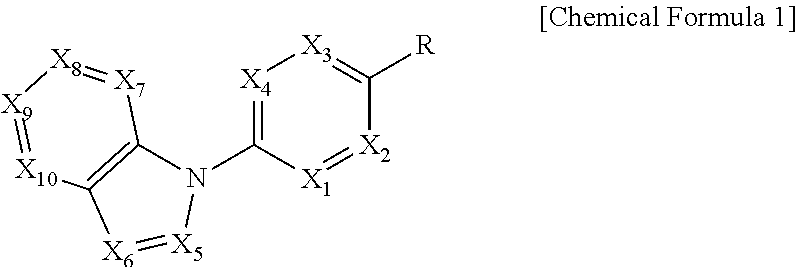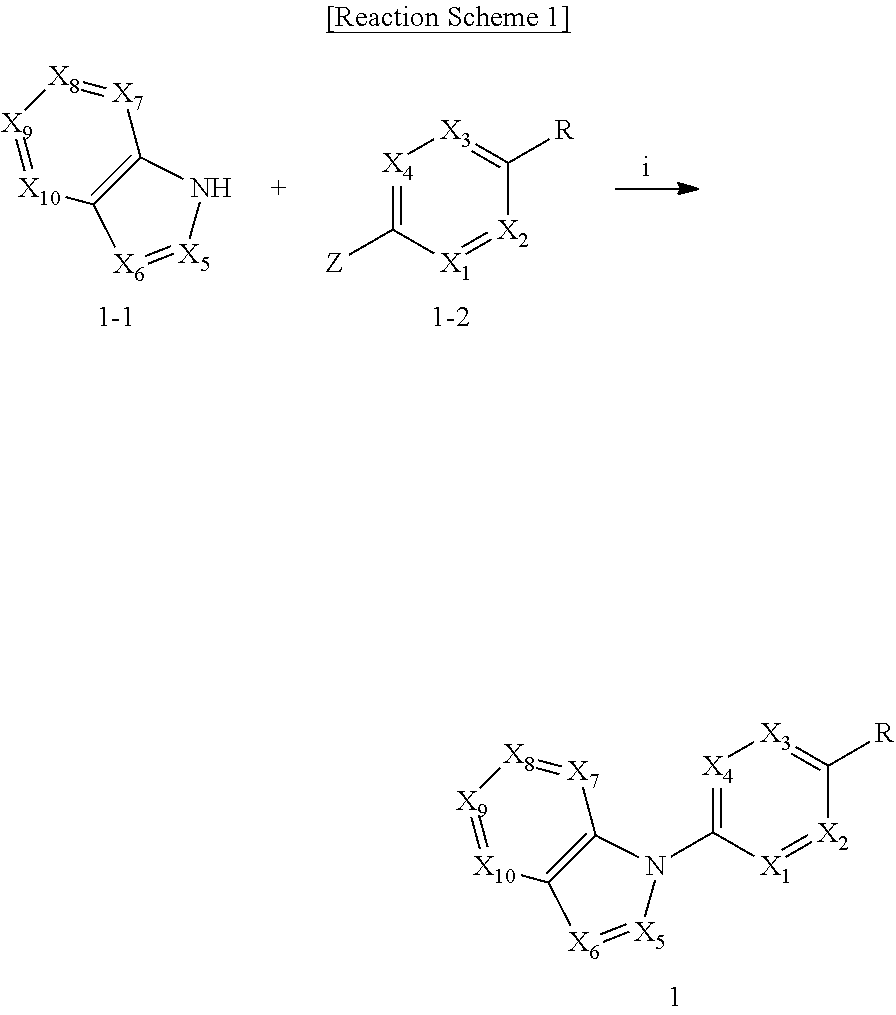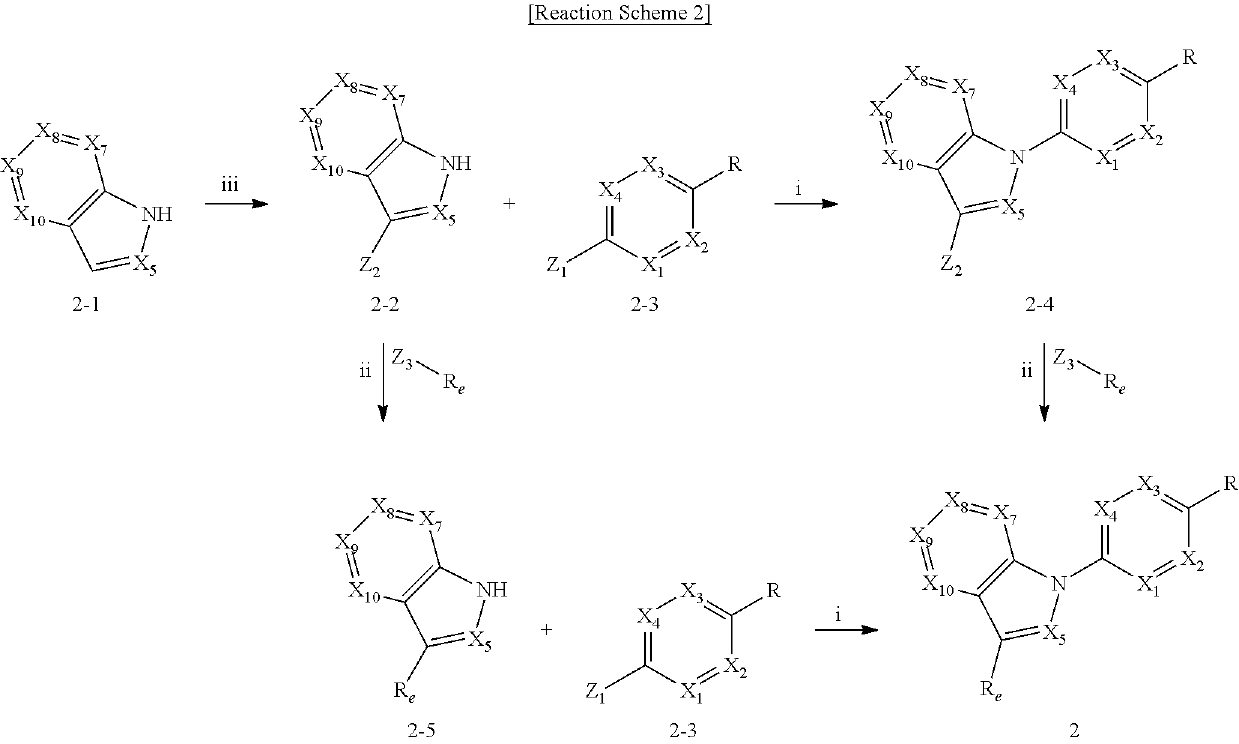Sodium channel blockers
a sodium channel and blocker technology, applied in the field of compounds having a blocking effect on sodium ion channels, can solve the problems of reducing neuropathic pain, skin may become red, hand, foot or face may swell, etc., and achieve the effect of effective us
- Summary
- Abstract
- Description
- Claims
- Application Information
AI Technical Summary
Benefits of technology
Problems solved by technology
Method used
Image
Examples
example 1
) Preparation of (5-chloro-4-(5-chloro-3-methyl-1H-indazol-1-yl)-2-fluoro-N-(methylsulfonyl)benzamide
[0431]
[0432]0.2 g (1.2 mmol) of 5-chloro-3-methyl-1H-indazole was dissolved in 10 mL of anhydrous N,N-dimethylformamide to which 0.78 g (2.4 mmol) of cesium carbonate and 0.32 g (1.2 mmol) of 5-chloro-2,4-difluoro-N-(methylsulfonyl)benzamide were added. The reaction mixture was stirred at 150° C. for 1 hour, and the organic layer was separated, treated with magnesium sulfate, filtered and then concentrated under reduced pressure. The residue was separated by column chromatography to give 0.15 g (30% yield) of the title compound.
[0433]1H NMR (MeOD) δ: 7.84 (s, 1H), 7.82-7.81 (d, 1H), 7.45-7.43 (d, 2H), 7.30-7.28 (d, 1H), 3.30 (s, 3H), 2.60 (s, 3H)
example 6
) Preparation of 4-(3-acetamido-5-chloro-1H-indazol-1-yl)-5-chloro-2-fluoro-N-(methylsulfonyl)benzamide
[0434]
[0435]0.1 g (0.24 mmol) of 4-(3-amino-5-chloro-1H-indazol-1-yl)-5-chloro-2-fluoro-N-(methylsulfonyl)benzamide was dissolved in 5 mL of anhydrous tetrahydrofuran to which 0.018 g (0.24 mmol) of acetyl chloride was added. The reaction mixture was stirred at room temperature for 2 hours, and the organic layer was separated, treated with magnesium sulfate, filtered and then concentrated under reduced pressure. The residue was separated by column chromatography to give 0.033 g (30% yield) of the title compound.
[0436]1H NMR (MeOD) δ: 7.80-7.99 (d, 1H), 7.64-7.62 (d, 1H), 7.40-7.38 (d, 1H), 7.28-7.27 (d, 2H), 3.15 (s, 3H), 2.25 (s, 3H)
example 24
) Preparation of 5-chloro-4-(3-chloro-5-cyclopropyl-1H-indazol-1-yl)-2-fluoro-N-(methylsulfonyl)benzamide
[0437]
[0438]25 mL of tetrahydrofuran was added to 1.0 g (7.0 mmol) of zinc(II) chloride under nitrogen conditions to which 4.0 mL (7.0 mmol, 1.7 M tetrahydrofuran) of cyclopropyl magnesium bromide was added, followed by stirring at room temperature for 30 minutes. The reaction mixture was added to 0.4 g (1.72 mmol) of 5-bromo-3-chloro-1H-indazole under nitrogen conditions, and then reacted with microwave reactor at 100° C. for 10 minutes. The organic layer was separated and concentrated under reduced pressure. The residue was separated by column chromatography to give 0.24 g (80% yield) of 3-chloro-5-cyclopropyl-1H-indazole.
[0439]1H NMR (MeOD) δ: 7.36 (d, 1H), 7.29 (s, 1H), 7.18 (d, 1H), 2.00 (m, 1H), 0.95 (d, 2H), 0.68 (d, 2H)
[0440]0.10 g (18% yield) of the title compound was prepared in the same manner as described in Example 1, except that 3-chloro-5-cyclopropyl-1H-indazole wa...
PUM
| Property | Measurement | Unit |
|---|---|---|
| temperature | aaaaa | aaaaa |
| pH | aaaaa | aaaaa |
| pH | aaaaa | aaaaa |
Abstract
Description
Claims
Application Information
 Login to View More
Login to View More - R&D
- Intellectual Property
- Life Sciences
- Materials
- Tech Scout
- Unparalleled Data Quality
- Higher Quality Content
- 60% Fewer Hallucinations
Browse by: Latest US Patents, China's latest patents, Technical Efficacy Thesaurus, Application Domain, Technology Topic, Popular Technical Reports.
© 2025 PatSnap. All rights reserved.Legal|Privacy policy|Modern Slavery Act Transparency Statement|Sitemap|About US| Contact US: help@patsnap.com



